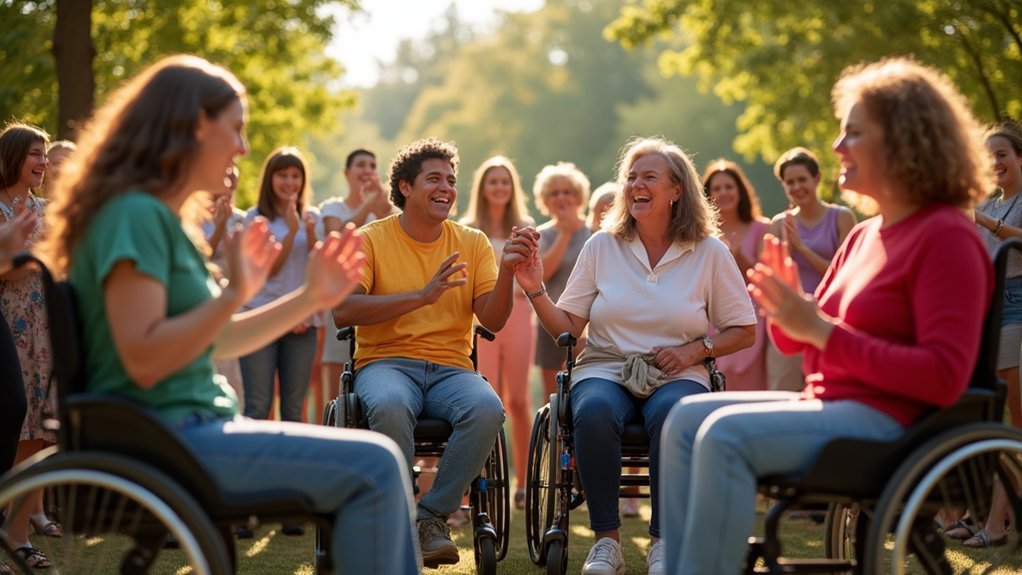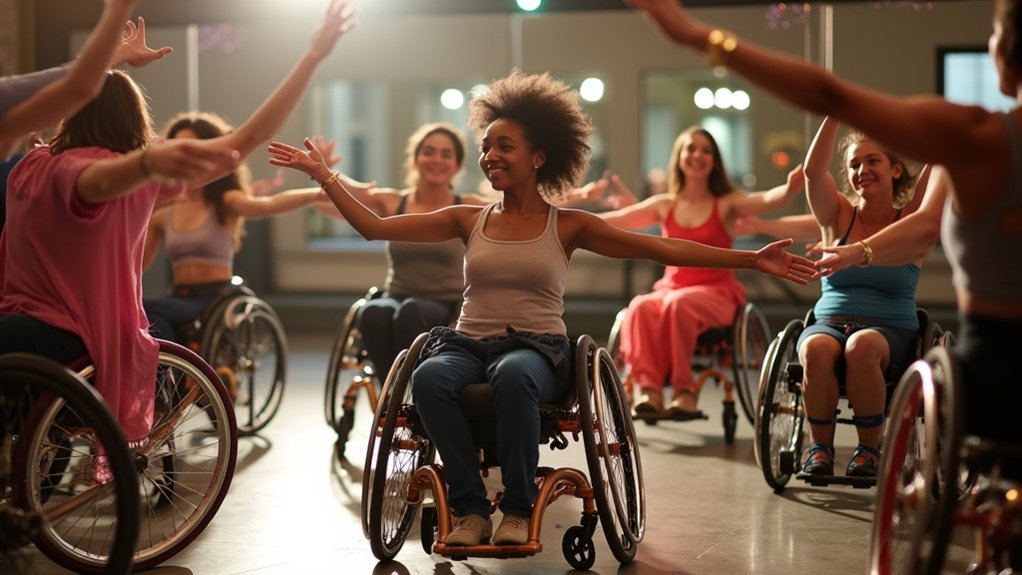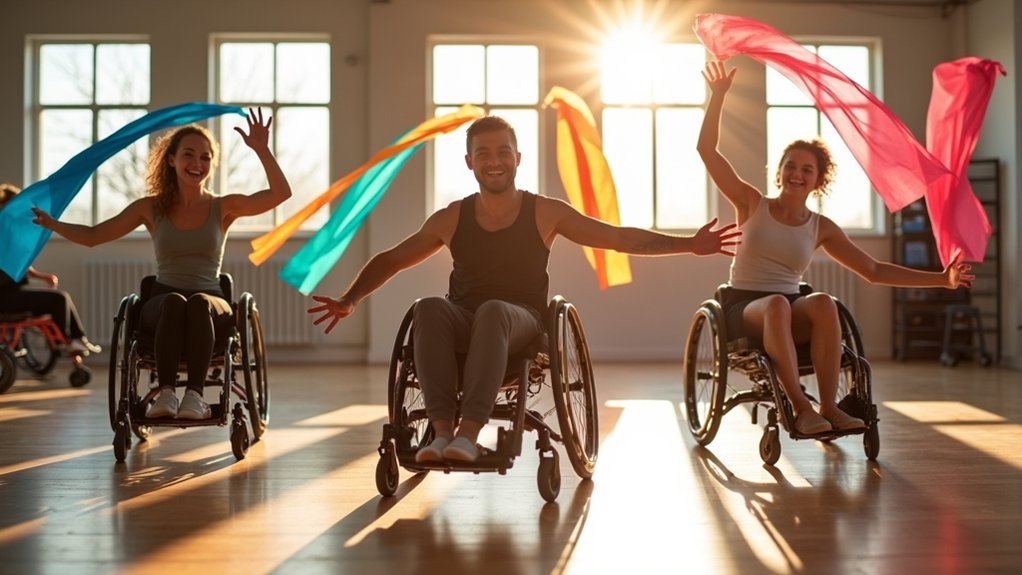Seated dance with adaptive mobility tools offers you a transformative rehabilitation approach beyond traditional exercises. You’ll improve cardiovascular health, flexibility, and muscle strength through accessible movements tailored to your abilities. These tools combine engineering with user-centered design to enhance your experience while providing essential social and psychological benefits. For conditions like Parkinson’s, dementia, and chronic heart failure, you’ll find effective therapeutic applications. Discover how inclusive movement arts are breaking barriers and revolutionizing rehabilitation for all mobility levels.
Revolutionizing Rehabilitation Through Seated Dance

While traditional rehabilitation methods often focus solely on physical exercises, seated dance emerges as a revolutionary approach that transforms the recovery process.
You’ll experience improved cardiovascular health through low-impact movements that don’t strain your joints while enhancing flexibility and muscle strength.
What makes seated dance truly revolutionary is its accessibility. You can participate regardless of mobility limitations, adapting movements to your specific needs. Classes are typically 45 minutes long and designed specifically with elderly participants’ needs in mind.
The cognitive benefits are equally impressive—the combination of music and choreography stimulates memory and attention while providing emotional expression outlets.
You’ll also build confidence in a socially engaging environment, reducing isolation often experienced during rehabilitation.
This holistic approach addresses your physical, emotional, and social wellbeing simultaneously, creating a thorough healing experience that traditional methods can’t match.
The Science Behind Adaptive Mobility Technology
At the heart of adaptive mobility technology lies a sophisticated interplay between engineering, medicine, and user-centered design principles. When you use these devices, you’re benefiting from IoMT technology that provides real-time feedback and customization to your specific needs.
| Technology Component | User Benefit |
|---|---|
| Sensor Fusion | Enhanced perception and responsiveness |
| IoT Integration | Real-time adaptation and feedback |
| Human-Machine Interface | Intuitive control and interaction |
| Autonomous Navigation | Independent movement in complex environments |
| Adaptive Algorithms | Learning and adjusting to your movement patterns |
The design of these tools incorporates perspectives from diverse disciplines like dance to improve movement dynamics. Traditional wheelchairs offer users limited movement options for expression and interaction, highlighting the need for more innovative designs. As you interact with your mobility device, sophisticated systems work to reduce cognitive overload while providing essential postural support—ultimately creating a seamless extension of your own mobility capabilities.
Breaking Barriers: Social and Psychological Benefits

Beyond their physical functionality, adaptive mobility tools offer profound social and psychological advantages that transform users’ lives.
When you participate in seated dance, you’re not just moving your body—you’re building community. These programs create inclusive spaces where people of all abilities connect, reducing isolation and fostering new friendships.
You’ll experience improved mental wellbeing as movement releases mood-enhancing endorphins while providing a creative outlet for emotional expression. The supportive environment builds confidence and positive self-image, regardless of physical limitations.
Seated dance particularly excels at facilitating intergenerational relationships and cultural exchange. Research shows that engaging in these activities helps seniors reduce fall risk while still enjoying the benefits of rhythmic movement.
As you learn new movements alongside others, you’ll develop a sense of belonging and purpose that extends beyond the dance floor, creating lasting social bonds that enrich your daily life.
Therapeutic Applications Across Different Health Conditions
Adaptive mobility tools have revolutionized therapeutic approaches across numerous health conditions, offering specialized benefits for diverse patient populations. You’ll find seated dance particularly effective for neurological disorders like Parkinson’s and dementia, where it improves motor function and cognitive skills. These activities provide an excellent option if you have limited mobility, as they incorporate sturdy chairs for essential safety during exercise.
| Condition | Primary Benefits | Therapeutic Approach |
|---|---|---|
| Dementia | Memory retention, cognitive function | Repetitive movements with musical cues |
| Parkinson’s | Motor control, balance | Rhythmic movement patterns |
| Chronic Heart Failure | Cardiovascular health | Low-impact seated cardio |
| Autism Spectrum | Stress reduction, expression | Non-verbal communication through movement |
For mental health conditions, you’ll experience reduced anxiety and depression symptoms while developing essential interpersonal skills. The non-verbal expression component is especially valuable if you struggle with traditional verbal therapies.
Designing the Future of Inclusive Movement Arts

Looking toward the future of adaptive mobility tools, innovative design approaches are reshaping inclusive movement arts for everyone.
You’ll find physical spaces evolving with wheelchair-accessible entrances and adaptive equipment that accommodate diverse bodies.
Virtual reality and AI-assisted technologies now offer immersive experiences for those with mobility limitations, while digital platforms provide flexible access to movement education regardless of your location. Projects like “From Stimming to Dance” transform repetitive movements into expressive dance forms for autistic children.
These tools feature built-in accessibility options like closed captioning.
Neurodivergent-led programs and sensory-based workshops are creating more authentic representation in the field.
When you participate in these phenomenon-based learning environments, you’ll engage with real-life concepts through multiple senses.
The most effective innovations happen when movement arts organizations collaborate with disability advocates, ensuring their spaces and programs truly meet your needs rather than assuming what works.
Frequently Asked Questions
How Much Do Adaptive Dance Mobility Chairs Typically Cost?
You’ll find adaptive dance mobility chairs cost between $200-$5,590. Basic models start around $300, mid-range options with hi-low bases run $1,000-$3,000, while advanced specialized chairs can exceed $4,000.
Can Insurance Cover Adaptive Mobility Tools for Dance Therapy?
Insurance rarely covers adaptive mobility tools for dance therapy as they’re classified as non-medical equipment. You’ll likely need alternative funding sources like grants, crowdfunding, or assistance programs from advocacy organizations to help with costs.
What Qualifications Do Seated Dance Instructors Need?
You’ll need dance experience, anatomy knowledge, and adaptive teaching skills. Many instructors hold degrees in performing arts and specialized certifications like Level 2 Seated Dance & Exercise Leader Certification for teaching seniors or those with disabilities.
How Do I Find Local Seated Dance Classes?
You’ll find local seated dance classes by searching online, checking community centers, contacting dance studios, browsing social media groups, and asking health organizations. Don’t forget to explore library programs and senior centers too.
Can I Customize an Existing Wheelchair for Dance Purposes?
Yes, you can customize your existing wheelchair for dance. Consider modifications to the frame, wheels, and seat for better maneuverability. Consult with adaptive equipment specialists to guarantee safety while enhancing performance capabilities.
In Summary
You’re redefining what dance means for those with mobility challenges. By embracing adaptive tools, you’re not just moving your body—you’re healing it, connecting with others, and reclaiming joy. Whether you’re recovering from injury or managing a chronic condition, seated dance offers freedom when standing isn’t an option. Don’t wait for perfect mobility; your dance journey starts where you are, exactly as you are.





Leave a Reply